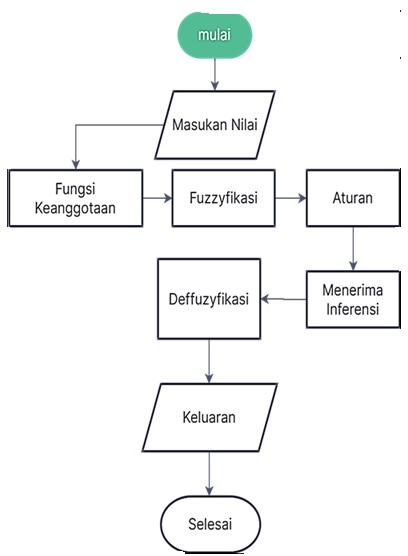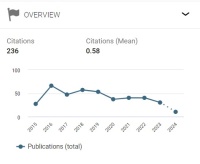Perankingan Dosen Berbasis Aktifitas Forum Moodle Menggunakan Metode Fuzzy Tsukamoto
Abstract
The online learning process currently utilizes a Learning Management System, one of which is Moodle. Moodle provides a forum menu where the forum is a digital forum for asking questions and answering and sharing between lecturers and students. Lecturer and student activity can be seen from the forum menu. For this reason, research was conducted on the ranking of lecturer activities in the moodle forum. The ranking determination uses the Fuzzy Tsukamoto decision making system. Fuzzy Tsukamoto has step efficiency in determining rules and processing data that has a taboo range and produces crips output. The processing steps carried out are determining the variables, giving weights, creating a fuzzy set of each variable, then the fuzzification process and creating a rule base and finally, defuzzification, namely the calculation of negligence and output. Based on the rule and the predicate alpha value, the appropriate value is obtained to rank the quality of lecturers based on their activities in the moodle forum.
Keywords — database, forum, fuzzy, moodle, tsukamoto
Downloads
References
[2] D. Sunardi and N. Okta, “Sistem Pendukung Keputusan Evaluasi Kinerja Dosen Sertifikasi Universitas Muhammadiyah Bengkulu Menggunakan Logika Fuzzy Pendahuluan Studi Literatur,” vol. 2, no. 1, pp. 51–61, 2019.
[3] C. Natasia, “Pemanfaatan Media E-Learning Moodle Untuk Menunjang Pembelajaran Mahasiswa di Fakultas Manajemen dan Bisnis Universitas Ciputra Pemanfaatan Media E-Learning Moodle Untuk Menunjang Pembelajaran …,” vol. 8, pp. 169–179, 2020.
[4] S. Rizal and B. Walidain, “Pembuatan Media Pembelajaran E-Learning Berbasis Moodle Pada Matakuliah Pengantar Aplikasi Komputer Universitas Serambi Mekkah,” J. Ilm. Didakt. Media Ilm. Pendidik. dan Pengajaran, vol. 19, no. 2, p. 178, 2019.
[5] R. Hadi, I. K. Gede Darma Putra, and I. N. Satya Kumara, “Penentuan Kompetensi Mahasiswa dengan Algoritma Genetik dan Metode Fuzzy C-Means,” Maj. Ilm. Teknol. Elektro, vol. 15, no. 2, pp. 101–106, 2016.
[6] L. T. H. Lan et al., “A new complex fuzzy inference system with fuzzy knowledge graph and extensions in decision making,” IEEE Access, vol. 8, pp. 164899–164921, 2020.
[7] N. Faisal, R. S. Hartati, and I. W. Sukerayasa, “Implementasi Fuzzy Logic dan Algoritma Genetika dalam Pemebebanan Ekonomis pada Sistem Pembangkitan di Bali,” Maj. Ilm. Teknol. Elektro, vol. 16, no. 3, p. 99, 2018.
[8] P. R. Nurbhawa, I. K. G. Darma Putra, and N. Gunantara, “Penentuan Lokasi Bts Pt. Smartfren Menggunakan Metode Fuzzy Ahp,” Maj. Ilm. Teknol. Elektro, vol. 16, no. 3, p. 63, 2017.
[9] J. P. Chang, Z. S. Chen, S. H. Xiong, J. Zhang, and K. S. Chin, “Intuitionistic Fuzzy Multiple Criteria Group Decision Making: A Consolidated Model with Application to Emergency Plan Selection,” IEEE Access, vol. 7, pp. 41958–41980, 2019.
[10] N. K. Ariasih, I. P. A. Bayupati, and I. K. G. Darmaputra, “Sistem Pendukung Keputusan Pemilihan Lokasi TPA Sampah Menggunakan Metode Min_Max Inference Fuzzy,” Maj. Ilm. Teknol. Elektro, vol. 14, no. 1, pp. 7–10, 2015.
[11] W. Herbimo, “Penerapan Aplikasi Moodle Sebagai Salah Satu Model Pembelajaran Jarak Jauh Di Masa Pandemi,” Ideguru J. Karya Ilm. Guru, vol. 5, no. 1, pp. 107–113, 2020.
[12] P. Metode et al., “Penerapan Metode Fuzzy Tsukamoto Dalam Pemilihan Siswa Teladan di Sekolah The Application of Fuzzy Tsukamoto Method in the Selection of Exemplary Students at School,” vol. 9, no. 1, pp. 9–15, 2020.
[13] I. G. S. E. Putra, I. K. G. D. Putra, and I. P. A. Bayupati, “Pengenalan Kepribadian Seseorang Berdasarkan Sidik Jari Dengan Metode Fuzzy Learning Vector Quantizationdan Fuzzy Backpropagation,” Maj. Ilm. Tek. Elektro, vol. 13, no. 2, 2014.
[14] W. Sanjaya, I. N. Sukajaya, and I. G. Gunadi, “Sistem Pendukung Keputusan Pemilihan Pemenang Pengadaan Jasa Konstruksi Pada Pemerintah Kota Denpasar dengan Metode Saw Berbasis Fuzzy,” Maj. Ilm. Teknol. Elektro, vol. 18, no. 1, p. 15, 2019.
[15] F. Satria and A. J. P. Sibarani, “Penerapan Metode Fuzzy Tsukamoto untuk Pemilihan Karyawan Terbaik Berbasis Java Desktop,” vol. x, no. x, pp. 130–143, 2020.
[16] H. Zakaria, S. T. Informatika, U. Pamulang, and T. Selatan, “SISTEM PENILAIAN KINERJA DOSEN DENGAN MENGGUNAKAN FUZZY INFERENCE SYSTEM METODE MAMDANI,” vol. 2, no. 4, 2021.
[17] L. P. Ayuningtias, “ANALISA PERBANDINGAN LOGIC FUZZY METODE TSUKAMOTO , SUGENO , DAN MAMDANI ( STUDI KASUS : PREDIKSI JUMLAH PENDAFTAR MAHASISWA BARU FAKULTAS SAINS DAN TEKNOLOGI UNIVERSITAS ISLAM NEGERI SUNAN GUNUNG DJATI BANDUNG ),” no. April, 2017.
[18] W. Liang, J. Wang, and Z. Deng, “HFGLDS: Hesitant Fuzzy Gained and Lost Dominance Score Method Based on Hesitant Fuzzy Utility Function for Multi-Criteria Decision Making,” IEEE Access, vol. 10, pp. 20407–20419, 2022.
[19] J. Wang, G. Wei, C. Wei, and Y. Wei, “Dual Hesitant q-Rung Orthopair Fuzzy Muirhead Mean Operators in Multiple Attribute Decision Making,” IEEE Access, vol. 7, pp. 67139–67166, 2019.
[20] S. Guo and Z. Qi, “A Fuzzy Best-Worst Multi-Criteria Group Decision-Making Method,” IEEE Access, vol. 9, pp. 118941–118952, 2021.
[21] J. P. Fan, R. Cheng, and M. Q. Wu, “Extended EDAS Methods for Multi-Criteria Group Decision-Making Based on IV-CFSWAA and IV-CFSWGA Operators with Interval-Valued Complex Fuzzy Soft Information,” IEEE Access, vol. 7, pp. 105546–105561, 2019.
[22] A. Ristyawan, “Penggunaan Fuzzy Tsukamoto Pada Algoritma SAW Dalam Kasus Pembobotan Judul Proposal Mahasiswa Pada Universitas ABC,” Semin. Nas. Teknol. Inf. dan Multimed., pp. 115–120, 2017.
[23] J. Jia, A. U. Rehman, M. Hussain, D. Mu, M. K. Siddiqui, and I. Z. Cheema, “Consensus-Based Multi-Person Decision Making Using Consistency Fuzzy Preference Graphs,” IEEE Access, vol. 7, pp. 178870–178878, 2019.
[24] S. Zhang, Z. Xu, X. J. Zeng, and X. Yan, “Integrations of Continuous Hesitant Fuzzy Information in Group Decision Making with a Case Study of Water Resources Emergency Management,” IEEE Access, vol. 8, pp. 146134–146144, 2020.
[25] Y. Hu and Z. Pang, “A novel similarity-based multi-attribute group decision-making method in a probabilistic hesitant fuzzy environment,” IEEE Access, vol. 10, no. October, pp. 110410–110425, 2022.
[26] M. M. Siswanto, “Metode Logika Fuzzy Tsukamoto Dalam Sistem Pengambilan Keputusan Penerimaan Beasiswa,” J. Media Infotama, vol. 9, no. 1, pp. 140–165, 2013.
[27] H. N. Hadi and W. F. Mahmudy, “Penilaian Prestasi Kinerja Pegawai Menggunakan Fuzzy Tsukamoto,” J. Teknol. Inf. dan Ilmu Komput., vol. 2, no. 1, p. 41, 2015.
[28] J. Feng, Q. Zhang, and J. Hu, “Group Generalized Pythagorean Fuzzy Aggregation Operators and Their Application in Decision Making,” IEEE Access, vol. 8, pp. 138004–138020, 2020.
[29] Z. Liu, M. Kong, and L. Yan, “Novel Transformation Methods among Intuitionistic Fuzzy Models for Mixed Intuitionistic Fuzzy Decision Making Problems,” IEEE Access, vol. 8, pp. 100596–100607, 2020.
[30] F. Jin, J. Liu, H. Chen, and R. Langari, “Interval Type-2 Trapezoidal Fuzzy Decision- Making Method with Consistency-Improving Algorithm and DEA Model,” IEEE Access, vol. 8, pp. 120456–120472, 2020.
[31] F. Ming, L. Wang, and J. Zhou, “The identification of poverty alleviation targets based on the multiple hybrid decision-making algorithms,” IEEE Access, vol. 8, no. 2017, pp. 169585–169593, 2020.
[32] C. Song, Y. Zhang, Z. Xu, Z. Hao, and X. Wang, “Route Selection of the Arctic Northwest Passage Based on Hesitant Fuzzy Decision Field Theory,” IEEE Access, vol. 7, pp. 19979–19989, 2019.
[33] M. M. S. Mohammad, S. Abdullah, and M. M. Al-Shomrani, “Some Linear Diophantine Fuzzy Similarity Measures and Their Application in Decision Making Problem,” IEEE Access, vol. 10, pp. 29859–29877, 2022.


This work is licensed under a Creative Commons Attribution-NonCommercial-NoDerivatives 4.0 International License.

This work is licensed under a Creative Commons Attribution 4.0 International License




